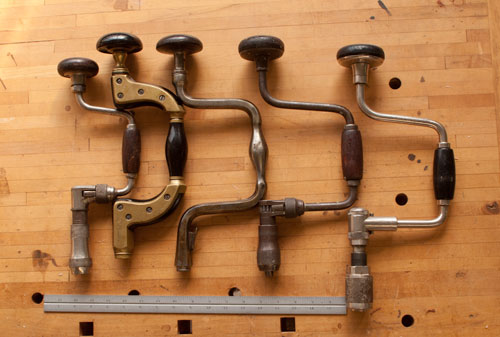|
|
08/10/2010 |
 In part one of brace tips - click here, I explained how to make your brace work for big holes. Now we look at the other extreme. Unfortunately the solution for small bits isn't as easy to do. For holes from 1/4" through 2" in diameter a brace was the hand tool of choice (although Jennings augur bits were made as small as 3/16"). For smaller sizes under a 1/4" egg beater style hand drills were usually used. With a small brace bits - say 1/4" - 1/2" you don't really need a lot of power but running the handle round and round in the 10" diameter circle of a typical brace is slow. Our ancestors wanted to speed things up - especially since drilling 1/4 - 1/2" holes in furniture is a very common operation. In part one of brace tips - click here, I explained how to make your brace work for big holes. Now we look at the other extreme. Unfortunately the solution for small bits isn't as easy to do. For holes from 1/4" through 2" in diameter a brace was the hand tool of choice (although Jennings augur bits were made as small as 3/16"). For smaller sizes under a 1/4" egg beater style hand drills were usually used. With a small brace bits - say 1/4" - 1/2" you don't really need a lot of power but running the handle round and round in the 10" diameter circle of a typical brace is slow. Our ancestors wanted to speed things up - especially since drilling 1/4 - 1/2" holes in furniture is a very common operation.
The solution was a "Quick" brace, which is simply a smaller sweep version of a regular brace, ratchet and all. The Stanley brace shown above at left has only a 3" throw for a total of a 6" sweep, and with it you can drill a lot faster.
Interestingly enough, while an English Ultimatum brace is under-powered for drilling large holes, it has a pretty fast stroke for drilling average sized holes found in traditional joinery. If you recall in part one I mentioned that the American braces drove the English off the market - by 1900 houses had plumbing, and early electrical wiring, all which needed pretty big holes drilled, and not too many drawbore joints where you just needed a small 1/4" hole. I wonder if there is a connection?
In the picture above the braces are ordered by sweep. Starting from the left is a 6" Stanley quick brace. Then comes an English Ultimatum brace with a 7" sweep, and a very lovely Scotch brace with a 9" sweep. Finally, the standard 10" American braces, which were mostly bought for house building not furniture.
If you come across a 6" quick brace, grab it!!!
Click here for Jennings Bits
|
Join the conversation |
|
 Joel's Blog
Joel's Blog Built-It Blog
Built-It Blog Video Roundup
Video Roundup Classes & Events
Classes & Events Work Magazine
Work Magazine


 In
In
I quote from the Oxford American Dictionary: "Scotch. of Scotland or Scottish people or their form of English. (Modern Scots prefer to use the word Scots or Scottish, not Scotch, except when the word is applied to whisky, Scotch Broth, Scotch Pine, Scotch Tape, Scotch Terrier, and Scotch Woodcock)." Scotch is OK when the Scottish dialect is being cited.
Dave Raeside
It's amazing to see how these tools evolved as the needs of carpenters/woodworkers changed. The application of the rachet to the brace must have been a significant breakthrough at the time. As it applied to housing in the 1900's with plumbing and electrical wiring, man hours would be saved, houses could be built faster, and it could have a positive impact on keeping costs down.
Great stuff! more please.